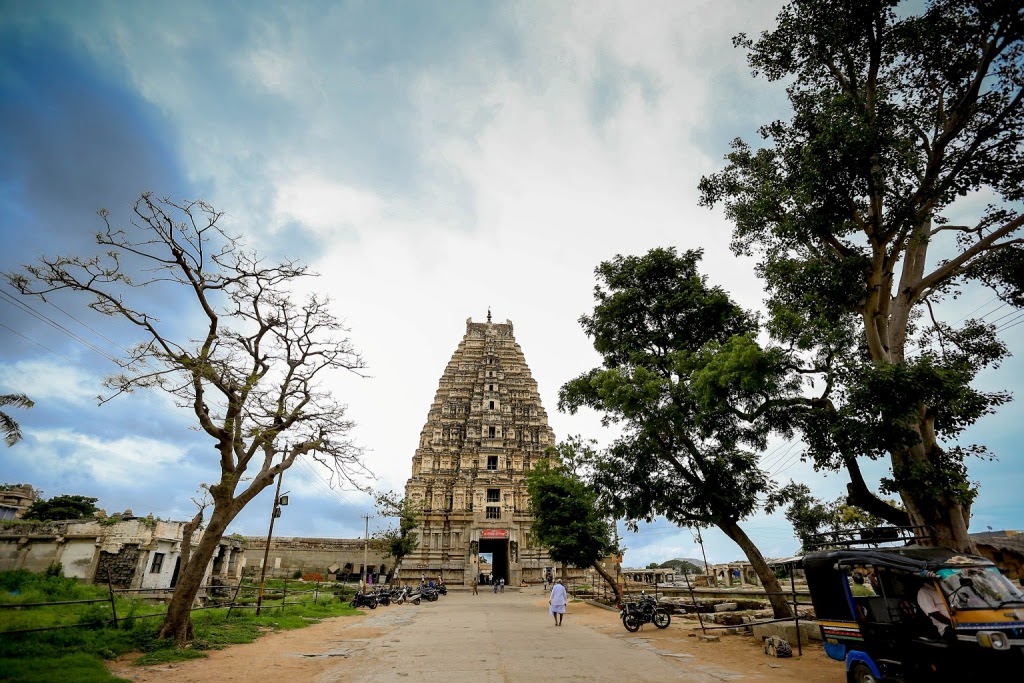Hampi Sri Virupaksha Temple, Karnataka

Address
Hampi Sri Virupaksha Temple, Hampi (Pampa Kshetra) Karnataka, Vijayanagara district, Karnataka- 583239
Diety
Shiva
Introduction
Hampi or Hampe, also referred to as the Group of Monuments at Hampi, is a UNESCO World Heritage Site located in east-central Karnataka, India. It is a pilgrimage centre of the Hindus Hampi was the capital of the Vijayanagara Empire in the 14th century.Chronicles left by Persian and European travellers, , say that Hampi was a prosperous, wealthy and grand city near the Tungabhadra River, with numerous temples, farms and trading markets. By 1500 CE, Hampi-Vijayanagara was the world’s second-largest medieval-era city after Beijing, and probably India’s richest at that time, attracting traders from Persia and Portugal. The Vijayanagara Empire was defeated by a coalition of Muslim sultanates; its capital was conquered, pillaged and destroyed by sultanate armies in 1565, after which Hampi remained in ruins spread over 4,100 hectares. of more than 1,600 surviving remains of the last great Hindu kingdom in South India that includes “forts, riverside features, royal and sacred complexes, temples, shrines, pillared halls, mandapas, memorial structures, water structures and others”. Hampi predates the Vijayanagara Empire; there is evidence of Ashokan epigraphy, and it is mentioned in the Ramayana and the Puranas of Hinduism as Pampaa Devi TirthaKshetra.Hampi continues to be an important religious centre, housing the Virupaksha Temple, an active AdiShankara-linked monastery and various monuments belonging to the old city.
Puranic Significance
The Virupaksha temple is the oldest shrine, the principal destination for pilgrims and remains an active Hindu worship site.Parts of the Shiva, Pampa and Durga temples existed in the 11th-century; it was extended during the Vijayanagara era.The temple is a collection of smaller temples, a regularly repainted, 50-metre (160 ft) high gopuram, a Hindu monastery dedicated to Vidyaranya of Advaita Vedanta tradition, a water tank , a community kitchen, other monuments and a 750 metres (2,460 ft)-long ruined stone market with a monolithic Nandi shrine on the east end. The temple faces eastwards, aligning the sanctums of the Shiva and Pampa Devi temples to the sunrise; a large gopuram marks its entrance. The superstructure is a pyramidal tower with plastered storeys on each of which is artwork. The gopuram leads into a rectangular court that ends in another, smaller gopuram dated to 1510 CE. To its south side is a 100-column hall with Hindu-related reliefs on all four sides of each pillar. Connected to this public hall is a community kitchen, a feature found in other major Hampi temples. A channel is cut into the rock to deliver water to the kitchen and the feeding hall. The courtyard after the small gopuram has dipa-stambha (lamp pillar) and Nandi. The courtyard after the small gopuram leads to the main mandapa of the Shiva temple, which consists of the original square mandapa and a rectangular extension composed of two fused squares and sixteen piers built by Krishnadevaraya. The ceiling of the open hall above the mandapa is painted, showing the Shaivism legend relating to Shiva-Parvati marriage; another section shows the legend of Rama-Sita of the Vaishnavism tradition. A third section depicts the legend of the love god Kama shooting an arrow at Shiva to get him interested in Parvati, and the fourth section shows the Advaita Hindu scholar Vidyaranya being carried in a procession. The mandapa pillars have outsized yalis, mythical animal melding the features of a horse, lion and other animals with an armed warrior riding it—a characteristic Vijayanagara feature. The sanctum of the temple has a mukha-linga; a Shiva linga with a face embossed with brass.The Virupaksha temple also has smaller shrines for two aspects of Parvati-Pampa and Bhuvaneshwari to the north of the main sanctum.Bhuvaneshwari shrine is of Chalukyan architecture and it uses granite instead of stone. The compound has a northern gopura, smaller than the eastern gopura, that opens to the Manmatha tank and a pathway to the river with stone reliefs related to the Ramayana. To the west of this tank are shrines of Shaktism and Vaishnavism traditions, such as those for Durga and Vishnu respectively According to local tradition, the Virupaksha is the only temple that continued to be a gathering place of Hindus and frequented by pilgrims after the destruction of Hampi in 1565. The temple attracts large crowds; an annual fête with a chariot procession to mark the marriage of Virupaksha and Pampa is held in spring, as is the solemn festival of MahaShivaratri.
Festivals
In the month of February the annual chariot festival is celebrated here every year& MahaShivaratri.
Century/Period/Age
13th-century CE
Managed By
UNESCO World Heritage Site
Nearest Bus Station
Hampi
Nearest Railway Station
Hosepet
Nearest Airport
Bellary









